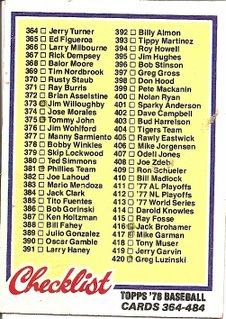'78 Checklist
 "Thus the power of souls is increased by all that men attribute to them, and in the end men find themselves the prisoners of this imaginary world of which they are, however, the authors and the models." – Emile Durkheim, The Elementary Forms of the Religious Life
"Thus the power of souls is increased by all that men attribute to them, and in the end men find themselves the prisoners of this imaginary world of which they are, however, the authors and the models." – Emile Durkheim, The Elementary Forms of the Religious LifeMy father was raised as an Orthodox Jew but traded religion for sociology as soon as he was old enough to live on his own. And only the faintest traces of the childhood Protestantism of my mother and stepfather survived the 1960s, Jesus showing up once a year in some Christmas carols sung by my Mom’s extended family while my brother and I played Mattel electronic football and wolfed down holiday peanut brittle.
So for me there was no church, no temple, no formal rites of passage, no fables of the afterlife, no prayers to the enrobed and sandal-clad Bee Gee. I was left to make it all up on my own. So here’s what I came up with, I guess: a half-assed worship of the names and statistics and mostly imagined capabilities of baseball players that I turned into deities. To fill in a box next to a name on a checklist such as the one pictured here was to take a tiny step out of this world and into the other world I was creating.
Some names were more important than others (as can be seen here, Topps had a numbering system that reflected a hierarchy of importance, the better players commanding the tens and the best players—such as number 400, Nolan Ryan—placed at the hundreds) but ultimately they were all of equal importance because they all were part of the Complete Set that I hoped to someday assemble. As suggested by the scant number of crudely filled-in boxes on this checklist, I never got anywhere near that imagined promised land, every box filled in, every name possessed, my own flimsy name gone, dissolved into gods.

2 Comments:
Kids today...
They just buy the whole set at once, fait accompli...
It's sick, I tell you.
Instsnt gratification. A sign of the times.
But hey,...that Jack Brohamer you managed to score must have been a minor thrill at the very least.
Confession: I used to mark up those checklists, and every so often, eyes furtively checking to see that the coast was clear, I'd cheat. I'd color in a box or three for cards I did not in fact possess.
I'm just going to leave this fact naked and unexplained. Perhaps I'll ponder it further; perhaps not.
Post a Comment
<< Home